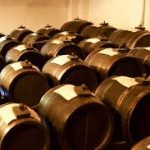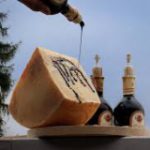Balsamic – No, not vinegar
 This week I had my first post lockdown pint. The Raeburn in Stockbridge has opened its outdoor bar as a takeaway. They have a large beer garden, which they can't use just now, so you have the daft sight of people leaning on the street side of the railings, looks of rapture on their faces. (For any licensees out there getting ideas, it must be remembered that Edinburgh is one of the relatively few places in Scotland not to have byelaws prohibiting the consumption of alcohol in unlicensed public places.) The price of a pint of beer is always a talking point. It may simply be included in the stats for inflation. Or, as any bar manager will tell you, it is something which, for some reason, causes extreme anger when it increases by a whopping 5p.
This week I had my first post lockdown pint. The Raeburn in Stockbridge has opened its outdoor bar as a takeaway. They have a large beer garden, which they can't use just now, so you have the daft sight of people leaning on the street side of the railings, looks of rapture on their faces. (For any licensees out there getting ideas, it must be remembered that Edinburgh is one of the relatively few places in Scotland not to have byelaws prohibiting the consumption of alcohol in unlicensed public places.) The price of a pint of beer is always a talking point. It may simply be included in the stats for inflation. Or, as any bar manager will tell you, it is something which, for some reason, causes extreme anger when it increases by a whopping 5p.
After working out the cost of an Imperial pint of today's featured ingredient, I promise never again to complain of price increases down the road at the Roseburn Bar. 568ml of Aceto Balsamico Tradizionale will set you back approximately £375. My recipe for berries with balsamic vinegar pearls stirred some interest, so I thought I'd write about the real thing.
You will note that the heading of today's article, is No, not vinegar. Now balsamic vinegar is a very fine product, one permanently to be found in my store cupboard, but If you go through life without knowing about the real stuff it would be a shame. The vinegar you buy is made up of a mixture of about 20% grape must, thinned down with ordinary vinegar, and often guddled about with caramel, artificial thickeners and sweeteners.
 The costly nectar itself is made in only two parts of Italy, Modena and Reggio Emilia. You can tell it not only by its price, but by the use of the word tradizionale on the label. The colour of that label will indicate its age. 12 years (red), 18 years (silver) and 25 years plus, (gold). The labelling system is slightly different in Modena, where a white cap indicates at least 12 years of age, and a gold cap adorns the extravecchio stuff, (25+ years)
The costly nectar itself is made in only two parts of Italy, Modena and Reggio Emilia. You can tell it not only by its price, but by the use of the word tradizionale on the label. The colour of that label will indicate its age. 12 years (red), 18 years (silver) and 25 years plus, (gold). The labelling system is slightly different in Modena, where a white cap indicates at least 12 years of age, and a gold cap adorns the extravecchio stuff, (25+ years)
 Making it is a vanity project - no one does it to get rich. You start with freshly crushed grape juice which is boiled down to reach a minimum sugar concentration of 30%. It is then put in a barrel with all the seeds, skins and stems. Then you let it age. And age and age. It is made using the same solera system as is used in the making of sherry. Unlike vintage wine which is matured in the same barrel, balsamic is decanted at intervals. Barrels of descending sizes are kept in rows (see left). The smaller ones with the oldest balsamico are kept topped up from the next largest, and so on.
Making it is a vanity project - no one does it to get rich. You start with freshly crushed grape juice which is boiled down to reach a minimum sugar concentration of 30%. It is then put in a barrel with all the seeds, skins and stems. Then you let it age. And age and age. It is made using the same solera system as is used in the making of sherry. Unlike vintage wine which is matured in the same barrel, balsamic is decanted at intervals. Barrels of descending sizes are kept in rows (see left). The smaller ones with the oldest balsamico are kept topped up from the next largest, and so on.
 The end result is extraordinary. It can be sipped from tiny glasses as a digestivo, but it comes into its own as the most extraordinary condiment. It can be used to enhance aged chunks of Parmesan cheese, or can be drizzled on to fresh strawberries. I have eaten it with ricotta, or, best of all, as the finest (and costliest) topping your ice cream will ever have. After much deliberation, I have just invested in my first tiny bottle of the stuff, Delivery has been delayed until I upgrade our security system. My justification is counting up all the money I've saved with restaurants being closed.
The end result is extraordinary. It can be sipped from tiny glasses as a digestivo, but it comes into its own as the most extraordinary condiment. It can be used to enhance aged chunks of Parmesan cheese, or can be drizzled on to fresh strawberries. I have eaten it with ricotta, or, best of all, as the finest (and costliest) topping your ice cream will ever have. After much deliberation, I have just invested in my first tiny bottle of the stuff, Delivery has been delayed until I upgrade our security system. My justification is counting up all the money I've saved with restaurants being closed.
But let's assume that you're not foolish enough to buy the real stuff. I would still recommend that a bottle of balsamic vinegar should be on the shelves of every serious cook. Prices vary enormously, but, to an extent, you get what you pay for. Just be sure to read the label carefully. You are looking for something that has a lovely agrodolce (sweet and sour) balance.
Not everyone will care for a dark brown salad dressing, but for me it makes the best of the lot. For years, my vinaigrette was made on a chuck it and chance it basis. One thing I knew for sure was that if you didn't get it right first time, you were doomed. Then someone gave me a gizmo from Lakeland Plastics (an unprepossessing shop, full of interesting stuff), a jar which had the measurements on it. Then that broke and I was back at sea until a very nice man at Martin Wishart Cookery School taught me the magic formula, three parts oil to one part acid. Here is my simple, fail safe recipe. If using vinegar other than balsamic, I add a good pinch of sugar. When running a cooking class for a friend, I found myself questioning why I add a little water. My mum's influence, perhaps? Then I saw Gordon Ramsay doing it, because that's what Pierre Koffmann taught him, so I rest my case. Use your best olive oil for this, Orodeal in my case.
Tom's Perfect Vinaigrette
 1tsp Dijon mustard; 3 tbsp Ordeal olive oil, or similar; 1 tbsp balsamic vinegar; pinch of salt; drizzle (about 1tsp) cold water. Mix all the ingredients together and stir or shake very well until emulsified. If not using at once, stir again before applying.
1tsp Dijon mustard; 3 tbsp Ordeal olive oil, or similar; 1 tbsp balsamic vinegar; pinch of salt; drizzle (about 1tsp) cold water. Mix all the ingredients together and stir or shake very well until emulsified. If not using at once, stir again before applying.
And did you know that in France the word they use meaning to dress salad is fatiguer - to make tired?
Thanks Tom – Every day’s a school day. I never knew about the grape must.
I just checked our bottle of Lidl’s balsamic vinegar and it contains only wine vinegar and 35% concentrated grape must – not bad value for €1.80!
Tastes ok too, to my untutored palette.
Even cheap balsamic vinegar is nice; however, we’ll save some of the really good stuff for you to try when you’re back next.
And I meant to say that the grape must in your bottle is probably about 4 weeks old. My Aceto Balsamico Tradizionale will have been 25 years in the making. Will it be worth it? I doubt it very much, but what’s wrong with the occasional bit of swank?
Interesting!
I’ve made vinaigrette over the years. But always included ground black pepper and touch of lemon juice.
Will try your recipe
It’s just personal taste, isn’t it? In mine I add salt but not pepper. Interested in your lemon juice. I have lost track of the number of things which are improved with a last minute splash of lemon. For me, in a vinaigrette, lemon is just one of your choices of acid. With the likes of a salad with hot smoked salmon or trout, I’d probably use lemon juice instead of vinegar in the dressing.
Most enjoyable as always Tom and educational as it is meant to be.
I think somewhere in a box I have maybe three of these bottles. White and gold balsamic vinegar. Nectar.
I must try and find them. They were packed when I moved out of Glasgow in September 2011